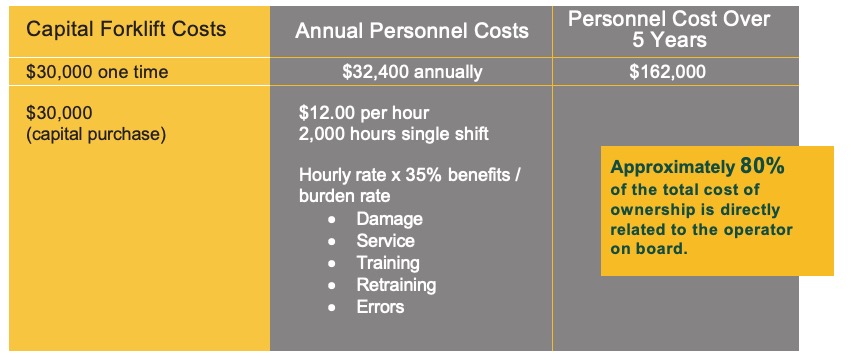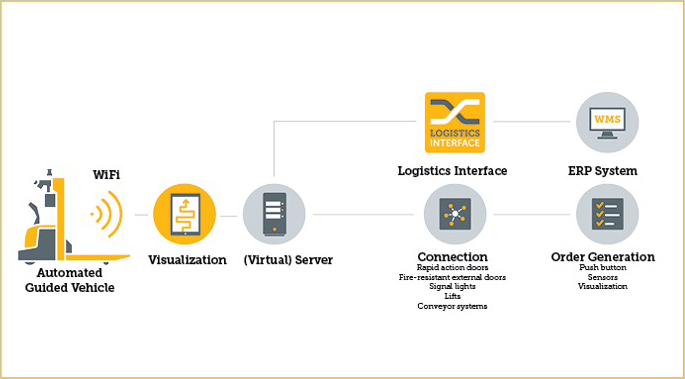The Case for Automation and Versatility in Today’s Warehouse
The price of AGVs might have scared off some businesses in the past, but the benefits and profitability are hard to ignore even for single shift operations.
Profitability, safety and productivity are at the forefront of any company’s mind, be they a local grocery store or an international supplier. Unexpected change in the world has once again proven that having consistent supply chain processes is critical to a company’s longevity—It has also accelerated the need for technology adoption. Automated Guided Vehicles (AGV) are setting the stage to revolutionize the intralogistics material flows of businesses around the world, allowing them to continue to operate and build resilience even in the most unprecedented of circumstances. Let’s take a look at some of the many benefits of AGVs.
Profitability
Historically, automated guided vehicle prices have led many to believe it is only financially practical for multi-shift, large-scale operations. It is true that two and three-shift applications yield compelling returns on investment. Advancement of AGV technologies in warehouse workforces have even made it so that single-shift operations can reap the benefits of automation.

*Costs will vary by model type, company and/or market.
AGVs provide their greatest value when used to take over processes that are routine and based around repeatable, predictable movements. Automating these basic, monotonous movements allows companies to diversify the job profile of their workforce and increase the potential and security of their logistics processes. It can also help to enable them to endure in times of change, uncertainty and duress. it allows for employees to refocus their talents by diminishing the amount of robotic movements they are tasked with on a daily basis. In essence, the adoption of automation is a catalyst for growth, regardless of the scale on which and in which it is integrated.
Safety
Whether in a period of economic growth or recession, it is none-the-less important that material flows remain durable, malleable and primed for growth. A Jungheinrich AGV can operate within a wide variety of customer applications, built upon software that allows it to be programmed around a multitude of production layouts and scales. The navigation systems equipped on these AGVs are implemented with flexibility and safety in mind, allowing for an AGV fleet to become increasingly versatile as its environment grows in both size and complexity. By utilizing route management and order prioritization logic, AGVs within a network have the capability to trade routes based on certain efficiency-maximizing parameters, such as battery levels, AGV warehouse location, changing order priority lists, etc.
Modern AGV navigation systems can now seamlessly integrate into mixed operation applications in which both automatic and manual lift trucks work in tandem. This type of mixed operation performance is made possible by equipping AGVs with extensive safety sensors, installed with the consideration that an AGV’s route will inevitably be interrupted by through-traffic in the warehouse. These safety sensors tell the AGV when to stop and when it is safe to go— allowing them to automatically continue their route progress once the path is clear.
The safety programming parameters on modern AGVs are extended to the preservation of warehouse infrastructure as well. Jungheinrich AGVs are set to communicate with certain landmarks along their routes, such as fire-doors and conveyor belts, in order to avoid collisions and facilitate high-precision pallet drop-off and pick-up procedures. Safety and preservation are deeply rooted into the core of an AGV design—they protect and enhance all aspects of a living and moving supply chain process.
Productivity
An AGV’s technological achievement does not end with its ability to safely and effectively guide itself through a complex warehouse space. These machines take full advantage of the latest innovations in energy navigation and interface systems.
Lithium-Ion Energy System
Most electric lift trucks currently found in warehouse operations are powered by lead-acid batteries which require labor-intensive maintenance, such as battery watering and removal, to remain viable. These maintenance procedures necessitate dedicated personnel and warehouse space. Lithium-ion batteries provide the latest in battery technology with fast charging times, minimal maintenance and extended life expectancy. Lithium-Ion batteries installed in AGVs can eliminate the drawbacks of traditional batteries. Lithium-Ion technology makes it possible for AGVs to charge in the most opportune moments between work cycles—for instance, an AGV within a fleet can be programmed to regularly stop at a charging station for intervals as short as 10 minutes, without harm to the battery’s life expectancy. With automated interval charging, an AGV fleet can run up to 24 hours a day, 7 days a week, without the need for manual interference.
Laser-Based Navigation System
Thanks to the adaptability of an AGV’s laser navigation, there is no need for extensive and costly warehouse conversion when integrating an AGV. Points of reference throughout the warehouse allow an AGV to easily find its way around any racking configuration, and laser navigation provides exact information about the vehicle’s position within a warehouse. The combination of millimeter-precise positioning and flexible warehouse mapping facilitates automated pallet jack or AGV’s ability to retrieve and deliver pallets with pin-point accuracy—ensuring a consistent material handling process.
Logistics Interface System
Jungheinrich AGV Systems take advantage of the Logistics Interface (LI) middleware, an in-house developed software which allows the vehicle to effortlessly communicate with pre-existing IT infrastructure, host systems and network landscapes in use at customer locations. This constant communication channel provides the information management teams need to effectively oversee warehouse movements and transport statistics. With real-time monitoring and reporting capabilities, Jungheinrich LI makes it simple to optimize supply chain procedures—for instance, live-tracking the relation between delays in a production cycle and the supply chain of that cycle can easily reveal buffer management anomalies and the necessary adjustments. Readily available data-visualization of automation enables companies to quickly analyze their supply chain processes in order to develop more efficient methods of movement and order prioritization.

What's Next
AGV benefits for business continue to grow as the technology improves. Constant evolution in the ideas and technologies that go into designing and building AGVs have made it so that there is no longer a need to choose between automation and versatility. Robotic workforces are becoming more agile and intelligent—powerful tools that customers can use to make their overall material handling processes more sustainable and reliable. Today, the blending of automated intelligence and human intellect creates a resilient, reflexive and distinctly modern union, fully prepared to overcome the challenges of a rapidly changing world.









